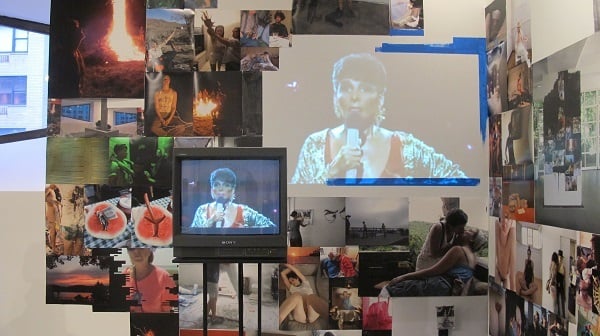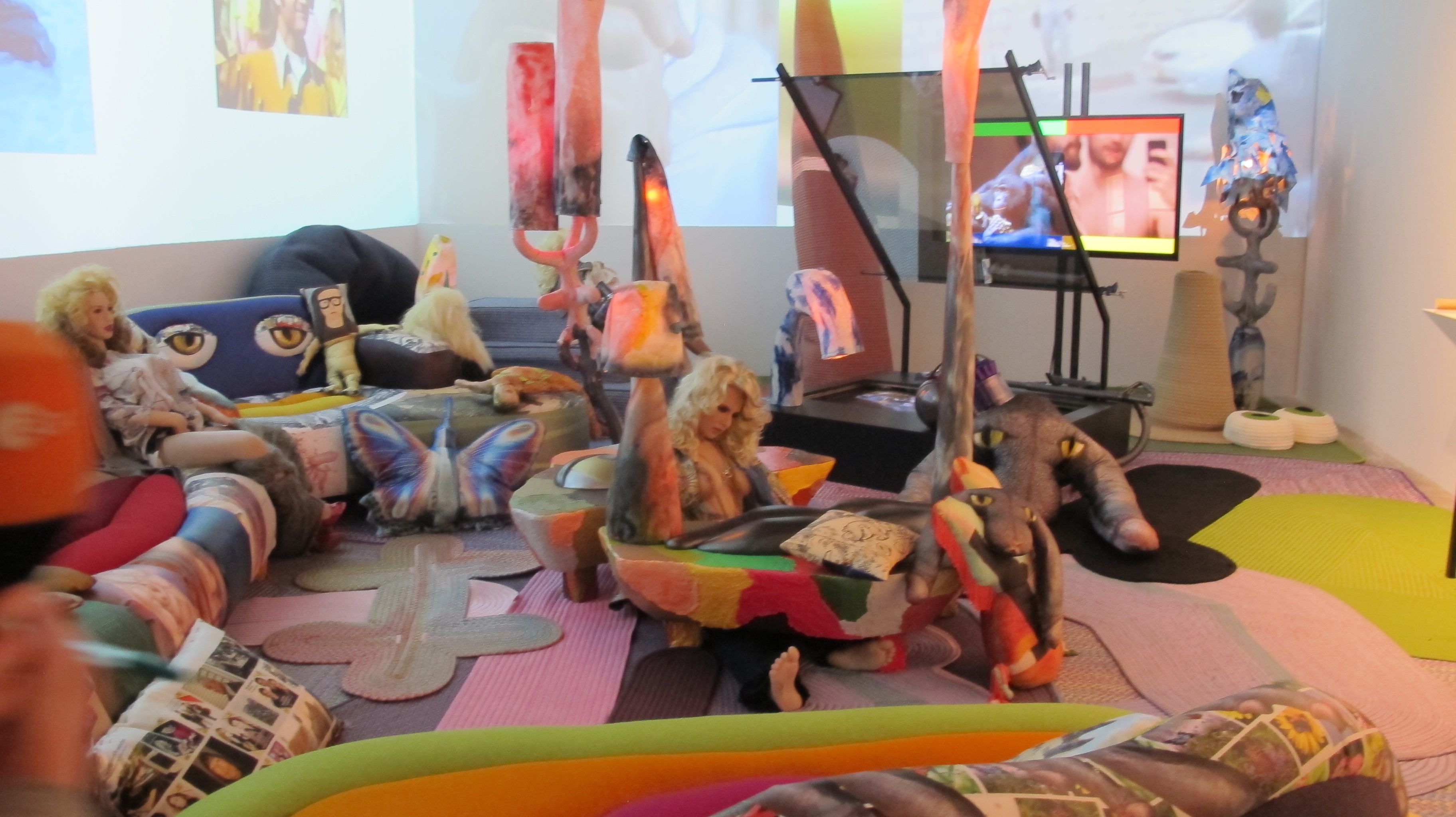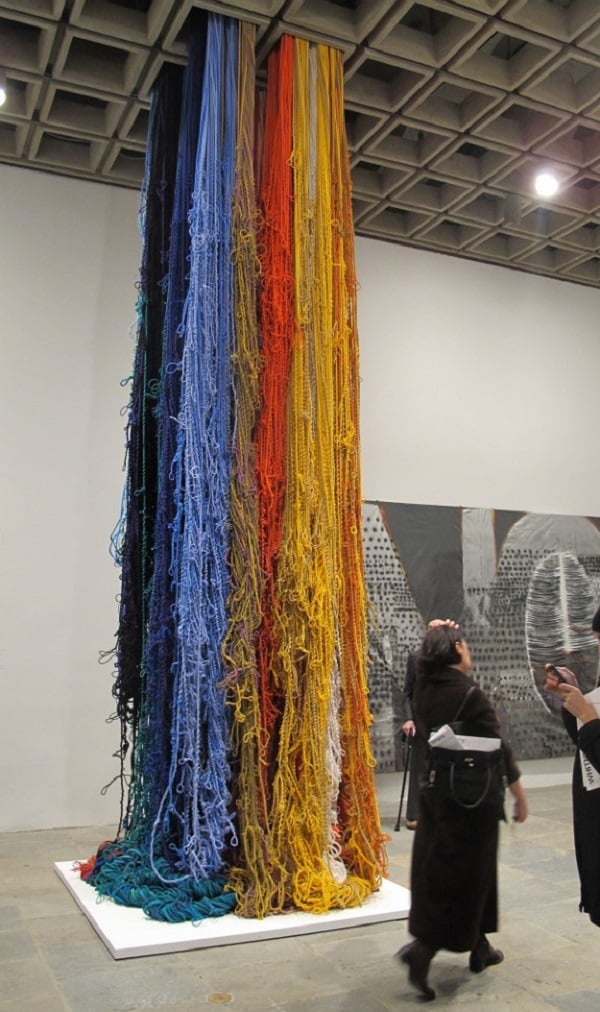Reviews
Critical Reduction: The 2014 Whitney Biennial
What nine critics say about the 103-artist exhibition.

What nine critics say about the 103-artist exhibition.

Benjamin Sutton

Whitney Biennial season is upon us, and, for better or worse the 2014 edition‘s unique, three-curator format seems to have paid off in one respect: Critics who typically fall over one another attempting to pen the most vicious take-down are having to hold back and consider each floor as practically separate shows. In this week’s edition of Critical Reduction, we tabulate no fewer than nine reviews of the 103-artist exhibition.
In the New York Times, Holland Cotter is bored by the Biennial—though he devotes most of his review to the many works that did manage to keep his interest—finding the exhibition at times indistinguishable from an art fair:
The result is a large, three-tiered cake of a show, mostly vanilla, but laced with threads of darker, sharper flavor, and with a lot of frosting on top. […]
Postmodern pluralism, which for two decades had made conservatives crazy, was turning out to be their best friend. It diluted political thinking and encouraged easy-on-the-eye luxe. Much of this year’s Biennial fits without resistance into the city’s concurrent art fair week. That’s the way things are. […]
Despite some good work assembled for this Biennial by three bright curators, I left feeling pretty much the way I do when I leave an art fair, full but empty, tired of dessert, hungry for a sustained and sustaining meal.
Cotter gives the 2014 Whitney Biennial a C+.
In the New Yorker, Peter Schjeldahl is typically non-committal in his critique, simultaneously seeming to praise and dismiss Grabner, Elms, and Comer’s floors, before finally letting his frustration show:
In the Biennial, only Grabner’s abstract-painting women feel engaged in healthy competition, challenging one another’s notions of what a painting should be and do. Elsewhere, it’s pretty much just one damned or, occasionally, blessed thing after another. […]
The show’s tributes to the dead seem telling. It’s as if only dying could decisively counter today’s unholy momentum, with its pressures to get with this or that program. Death suspends practice.
Schjeldahl gives the 2014 Whitney Biennial a C.
In New York magazine, Jerry Saltz is infatuated with Grabner’s floor, but finds the rest of the Biennial insufferably careful and stuffy, calling into question the inclusion of so many older and dead artists:
Yet such emphasis on older practitioners makes this biennial come off as a dodge, as if the curators were scared of making a wrong call. Or they haven’t spent enough time in the trenches (as opposed to flying around the world participating in symposiums with like-minded curators), and have lost touch with what might be going on beyond what they already know.
The curators are so determined to stay pure, to avoid acknowledging the machinations of commerce, that the show is completely disconnected from the entire world.
Saltz gives the 2014 Whitney Biennial a D.
In the New York Observer, Andrew Russeth considers the three-curator format a cop-out, and steadily loses interest as he works his way down from Grabner’s fourth-floor presentation:
This three-part approach amounts to a dodge, an attempt to please too many constituencies that will instead please no one. With 103 participants—twice the number in 2012’s excellent, poetic edition, which was organized by Jay Sanders and Elisabeth Sussman, Whitney curators who advised this year’s triumvirate—the overstuffed biennial is back, shortchanging artists.
In a sense, though, it feels like an honest description of today’s art world, which is deeply riven, between money and the museum, pop culture and the underground, and marked by competing visions. The biennial captures—or is perhaps just caught up in—this fraught, tense moment, but is unable to make anything fruitful out of it.
Russeth gives the Whitney Biennial a D.

Bjarne Melgaard’s installation at the 2014 Whitney Biennial.
Photo: Rozalia Jovanovic.
On Hyperallergic, Hrag Vartanian did the logical thing and split the three floors into three separate reviews. Beginning on Grabner’s fourth floor, he writes:
While Grabner’s introductory wall text was a little off-putting—she “considered the job of organizing the Biennial as being more ‘curriculum building’ than curating,” whatever that means—her selections were attractive, conceptually interesting, and fearless in its integration of porcelain, ceramic, and more painting than we’ve been accustomed to seeing at recent Whitney Biennials.
Of the Comer-curated third floor, he writes:
This floor also had the misfortune of having some of the worst pieces in the show, most of which looked like frat house hijinks gone wrong. […]
Comer’s role in the Whitney Biennial appeared to be to poke and prod the boundaries between various categories, exploring the state of becoming again and again. That sense of experimentation was most certainly welcome.
And on Anthony Elms’s second floor he concludes:
Judging from the exhibition, you’d think American culture was in retreat, but the opposite is the case in the age of the internet. There’s a strange timidness to this biennial that made it feel as manicured as a public garden, where things never get too wild, too dangerous, or too exciting. One thing is for sure—this isn’t the American art I’m seeing in the world today.
Vartanian gives the Whitney Biennial a C.
Also on Hyperallergic, Jillian Steinhauer bemoans the nearly complete absence of politically or socially engaged work in the Biennial:
For the most part, the art in this year’s biennial faces inward, reflecting on itself and sometimes the larger world in safe and comfortable ways. You won’t be too put out, turned off, or riled up. You’ll probably just have a good time. […]
But that’s just the issue: the biennial is overly neat and likeable, scarcely messy or funny or challenging. […]
Is that a disastrous thing? No. Is it a shortcoming? Absolutely. All art need not be political, but a show that disregards politics in the United States in 2014 is a delusion—not simply because of the state of the country and the world, but also because of the state of art itself.
Steinhauer gives the 2014 Whitney Biennial a C-.
At Artinfo, Wendy Vogel praises the Biennial’s archival and historical tendencies:
In the end, the final Breuer Biennial may be criticized for its multilayered approach. But its scope reveals an optimism that distinguishes it from many recent surveys. With additional events and performance “residencies” scheduled over the next three months, the 2014 Whitney Biennial suggests that although history is accessible via gadgets, you still may want to grab an old-fashioned front row seat for the present.
Vogel gives the 2014 Whitney Biennial a B.
In Time Out New York, Howard Halle gives the Biennial three stars out of five, and the ensuing review makes it clear that his expectations were only met because they were extremely low:
Somehow it works, or at least it does so enough of the time to make this Biennial seem better than most. I know: faint praise! Still, this edition should be remembered for its inclusion of paintings in pretty decent numbers, as well as its emphasis on semiforgotten careers and artists from outside New York. […]
Ultimately, the 2014 Biennial is somewhat square, even provincial, and that may be okay for now. Because truthfully, the formula is impervious to change. You could scour the planet and probably find enough artists to mount a truly mind-blowing survey every other year. But that supposes the Biennial is just a show when it’s really not. It’s a brand, and like any brand, genuine risk makes its shareholders nervous.
Halle gives the 2014 Whitney Biennial a C+.
Over at Artspace, Ian Wallace identifies five major trends from this year’s Biennial—”Showing One’s Works,” “Words Without Pictures,” “Rooms Within Rooms,” “Underrepresented Artists,” and “Theatrical Effect”—in a generally favorable review:
In terms of content, much of the work this year seems to be revisiting the crisis of the “post-medium condition” (e.g. the liberation of a painting from having to just be a painting), as famously described by critic Rosalind Krauss, albeit from a retrospective—perhaps even nostalgic—point of view, imagining possible futures for art-making in the wake of both rapid progressions in technology and the dematerialization of the art object.
Wallace gives the 2014 Whitney Biennial a B.
The Critical Reduction Super Grade for the 2014 Whitney Biennial, which continues at the Whitney Museum in New York through May 25, is a C.
A Note on Methodology: To arrive at the final Critical Reduction Super Grade, the grade for each critic is converted to a number from 1 to 5; an A is worth 5, a B is worth 4, a C is worth 3, a D is worth 2, and an F is worth 1, with pluses and minuses counting as .5 more or .5 less. Those numbers are summed and divided by the number of reviews being considered (in this case, nine). The resulting total is rounded up or down to the closest whole or half number (in this case, 3) and assigned the corresponding letter grade.

Sheila Hicks, Pillar of Inquiry/Supple Column (2013–14).
Photo: Rozalia Jovanovic.